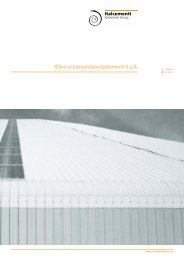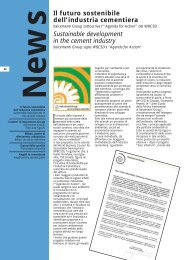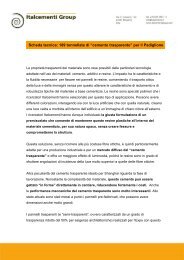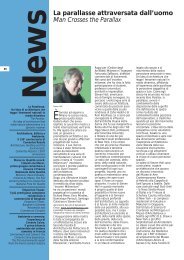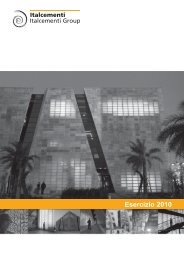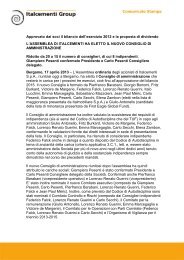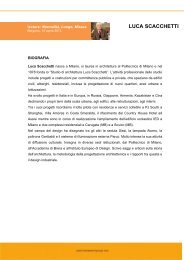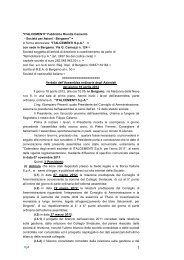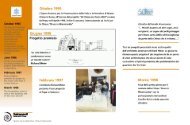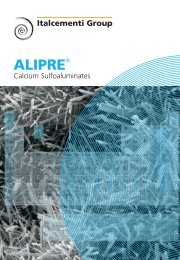2011 Annual Report - Italcementi Group
2011 Annual Report - Italcementi Group
2011 Annual Report - Italcementi Group
Create successful ePaper yourself
Turn your PDF publications into a flip-book with our unique Google optimized e-Paper software.
<strong>2011</strong> <strong>Annual</strong> <strong>Report</strong><br />
Presentation 4<br />
General information 15<br />
<strong>Annual</strong> <strong>Report</strong> Consolidated <strong>Annual</strong> <strong>Report</strong> Directors’ report 150<br />
Extraordinary session <strong>Italcementi</strong> S.p.A. <strong>Annual</strong> <strong>Report</strong> Separate financial statements 239<br />
1.9. Investment property<br />
Investment property is land and/or buildings held to earn rental income and/or for capital appreciation, rather<br />
than for use in the production or supply of goods and services. Investment property is initially recognized at<br />
purchase cost, including costs directly attributable to the purchase. Subsequent to initial recognition,<br />
investment property is measured at amortized cost.<br />
1.10. Intangible assets<br />
Intangible assets purchased separately are capitalized at cost, while those acquired through business<br />
combinations are recognized at provisionally estimated fair value at the acquisition date and adjusted where<br />
necessary within the following twelve months.<br />
Subsequent to initial recognition, intangible assets are carried at cost amortized over the asset’s useful life.<br />
The company has not identified intangible assets with an indefinite useful life.<br />
1.11. Impairment<br />
Property, plant and equipment and investment property, and amortizable intangible assets, are tested for<br />
impairment if indications of impairment emerge.<br />
Assets represented by equity investments in companies recorded at cost are tested for impairment if<br />
indications of impairment emerge.<br />
Impairment is the difference between the asset carrying amount and its recoverable amount. Recoverable<br />
amount is the greater of fair value, less costs to sell, of an asset or cash-generating unit, and its value in use,<br />
determined as the present value of future cash flows.<br />
Fair value less costs to sell is determined through application of relevant valuation models adopting<br />
appropriate income multipliers, quoted share prices on an active market for similar enterprises or other<br />
available fair value indicators applicable to the assets being measured.<br />
In determining value in use, assets are measured at the level of cash-generating units on a continuing<br />
operations basis. Estimated future cash flows are discounted at a rate determined for each cash-generating<br />
unit using the weighted average cost of capital method (WACC).<br />
If an impairment loss on an asset other than goodwill subsequently reverses in full or in part, the asset carrying<br />
amount is increased to reflect the new estimated recoverable amount, which may not exceed the amount that<br />
would have been reflected in the absence of the impairment loss. Impairment losses and reversals of<br />
impairment losses are taken to the income statement.<br />
1.12. Financial assets<br />
All financial assets are recognized initially at cost at the purchase date. Cost corresponds to fair value plus<br />
additional costs attributable to the purchase.<br />
Subsequent to initial recognition, assets held for trading are classified as current financial assets and carried at<br />
fair value; any gains or losses are taken to the income statement.<br />
Held-to-maturity investments are classified as current financial assets, if they mature within one year;<br />
otherwise they are classified as non-current assets and subsequently carried at amortized cost. Amortized cost<br />
is determined using the effective interest rate method, taking account of any acquisition discounts or<br />
premiums, which are apportioned over the entire period until maturity, less any impairment losses.<br />
Other financial assets are classified as available for sale and measured at fair value. Any gains or losses are<br />
shown in a separate equity caption until the assets are sold, recovered or discontinued, or until they are found<br />
to be impaired, in which case the cumulative gains or losses in equity are taken to the income statement.<br />
Equity instruments that are not listed on an active market and whose fair value cannot be measured reliably<br />
are carried at cost.<br />
251<br />
www.italcementigroup.com




